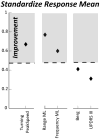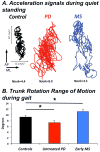Mobility Lab to Assess Balance and Gait with Synchronized Body-worn Sensors
- PMID: 24955286
- PMCID: PMC4062543
- DOI: 10.4172/2155-9538.S1-007
Mobility Lab to Assess Balance and Gait with Synchronized Body-worn Sensors
Abstract
This paper is a commentary to introduce how rehabilitation professionals can use a new, body-worn sensor system to obtain objective measures of balance and gait. Current assessments of balance and gait in clinical rehabilitation are largely limited to subjective scales, simple stop-watch measures, or complex, expensive machines not practical or largely available. Although accelerometers and gyroscopes have been shown to accurately quantify many aspects of gait and balance kinematics, only recently a comprehensive, portable system has become available for clinicians. By measuring body motion during tests that clinicians are already performing, such as the Timed Up and Go test (TUG) and the Clinical Test of Sensory Integration for Balance (CITSIB), the additional time for assessment is minimal. By providing instant analysis of balance and gait and comparing a patient's performance to age-matched control values, therapists receive an objective, sensitive screening profile of balance and gait strategies. This motion screening profile can be used to identify mild abnormalities not obvious with traditional clinical testing, measure small changes due to rehabilitation, and design customized rehabilitation programs for each individual's specific balance and gait deficits.
Conflict of interest statement
Drs. Salarian, Holmstrom, McNames and Horak have significant financial interests in APDM, a company that has a commercial interest in the results of this research and technology. This potential conflict of interest has been reviewed and managed by OHSU and the Integrity Oversight Council.
Figures







Similar articles
-
Role of body-worn movement monitor technology for balance and gait rehabilitation.Phys Ther. 2015 Mar;95(3):461-70. doi: 10.2522/ptj.20140253. Epub 2014 Dec 11. Phys Ther. 2015. PMID: 25504484 Free PMC article.
-
Body-worn motion sensors detect balance and gait deficits in people with multiple sclerosis who have normal walking speed.Gait Posture. 2012 Apr;35(4):573-8. doi: 10.1016/j.gaitpost.2011.11.026. Epub 2012 Jan 25. Gait Posture. 2012. PMID: 22277368 Free PMC article.
-
Body-worn sensors capture variability, but not decline, of gait and balance measures in multiple sclerosis over 18 months.Gait Posture. 2014 Mar;39(3):958-64. doi: 10.1016/j.gaitpost.2013.12.010. Epub 2013 Dec 21. Gait Posture. 2014. PMID: 24405749 Free PMC article.
-
Objective biomarkers of balance and gait for Parkinson's disease using body-worn sensors.Mov Disord. 2013 Sep 15;28(11):1544-51. doi: 10.1002/mds.25684. Mov Disord. 2013. PMID: 24132842 Free PMC article. Review.
-
Potential of APDM mobility lab for the monitoring of the progression of Parkinson's disease.Expert Rev Med Devices. 2016 May;13(5):455-62. doi: 10.1586/17434440.2016.1153421. Expert Rev Med Devices. 2016. PMID: 26872510 Free PMC article. Review.
Cited by
-
A Systematic Review of Thirty-One Assessment Tests to Evaluate Mobility in Older Adults.Biomed Res Int. 2019 Jun 20;2019:1354362. doi: 10.1155/2019/1354362. eCollection 2019. Biomed Res Int. 2019. PMID: 31321227 Free PMC article.
-
Factors affecting postural instability after more than one-year bilateral subthalamic stimulation in Parkinson's disease: A cross-sectional study.PLoS One. 2022 Feb 23;17(2):e0264114. doi: 10.1371/journal.pone.0264114. eCollection 2022. PLoS One. 2022. PMID: 35196348 Free PMC article.
-
A novel digital biomarker of sarcopenia in frail elderly: New combination of gait parameters under dual-task walking.Front Aging Neurosci. 2023 Feb 20;15:1087318. doi: 10.3389/fnagi.2023.1087318. eCollection 2023. Front Aging Neurosci. 2023. PMID: 36891555 Free PMC article.
-
Less Is More - Estimation of the Number of Strides Required to Assess Gait Variability in Spatially Confined Settings.Front Aging Neurosci. 2019 Jan 21;10:435. doi: 10.3389/fnagi.2018.00435. eCollection 2018. Front Aging Neurosci. 2019. PMID: 30719002 Free PMC article.
-
Instrumented Gait Analysis to Identify Persistent Deficits in Gait Stability in Adults With Chronic Vestibular Loss.JAMA Otolaryngol Head Neck Surg. 2021 Aug 1;147(8):729-738. doi: 10.1001/jamaoto.2021.1276. JAMA Otolaryngol Head Neck Surg. 2021. PMID: 34196673 Free PMC article.
References
-
- Rossier P, Wade DT. Validity and reliability comparison of 4 mobility measures in patients presenting with neurologic impairment. Arch Phys Med Rehabil. 2001;82 (1):9–13. - PubMed
-
- Frontera W. The importance of technology in rehabilitation. IEEE Eng Med Biol Mag. 2003;22 (3):25. - PubMed
-
- Binkley PF. The next era of examination and management of the patient with cardiovascular disease. IEEE Eng Med Biol Mag. 2003;22 (3):23–24. - PubMed
-
- Ebersbach G, Baas H, Csoti I, Mungersdorf M, Deuschl G. Scales in Parkinson’s disease. J Neurol. 2006;253(Suppl 4):IV32–35. - PubMed
-
- Lord SE, Rochester L. Measurement of community ambulation after stroke: current status and future developments. Stroke. 2005;36 (7):1457–1461. - PubMed
Grants and funding
LinkOut - more resources
Full Text Sources
Other Literature Sources
Medical
Miscellaneous
